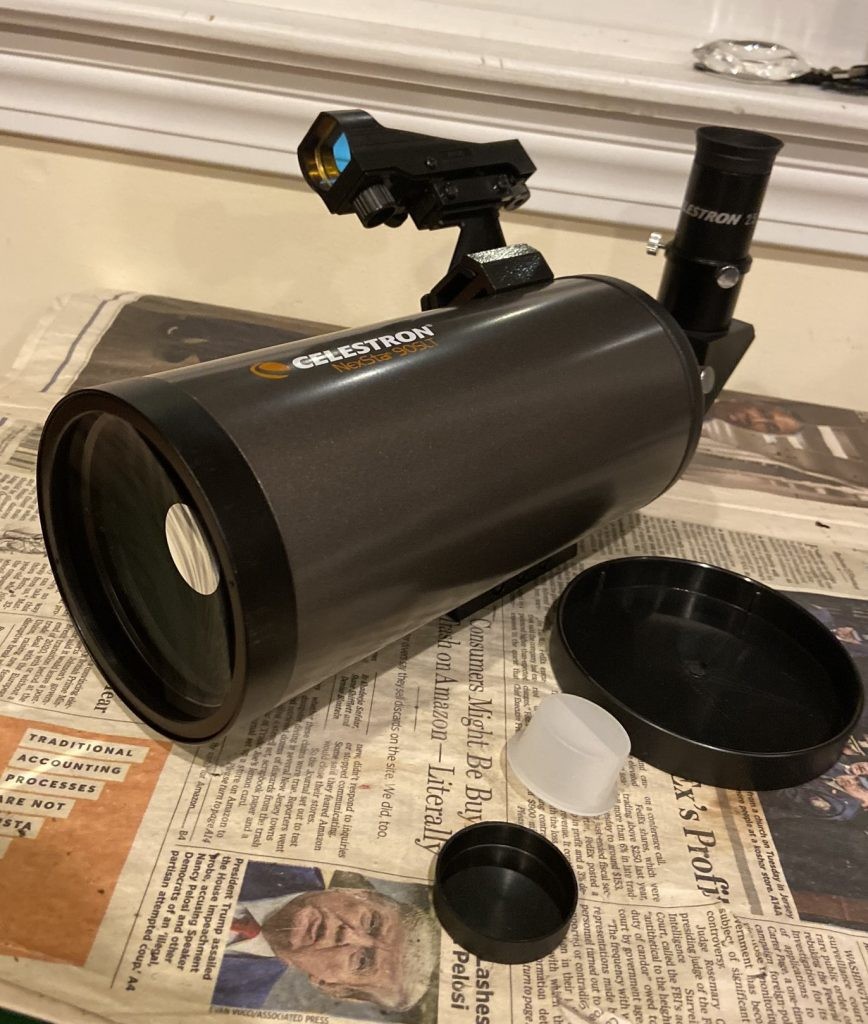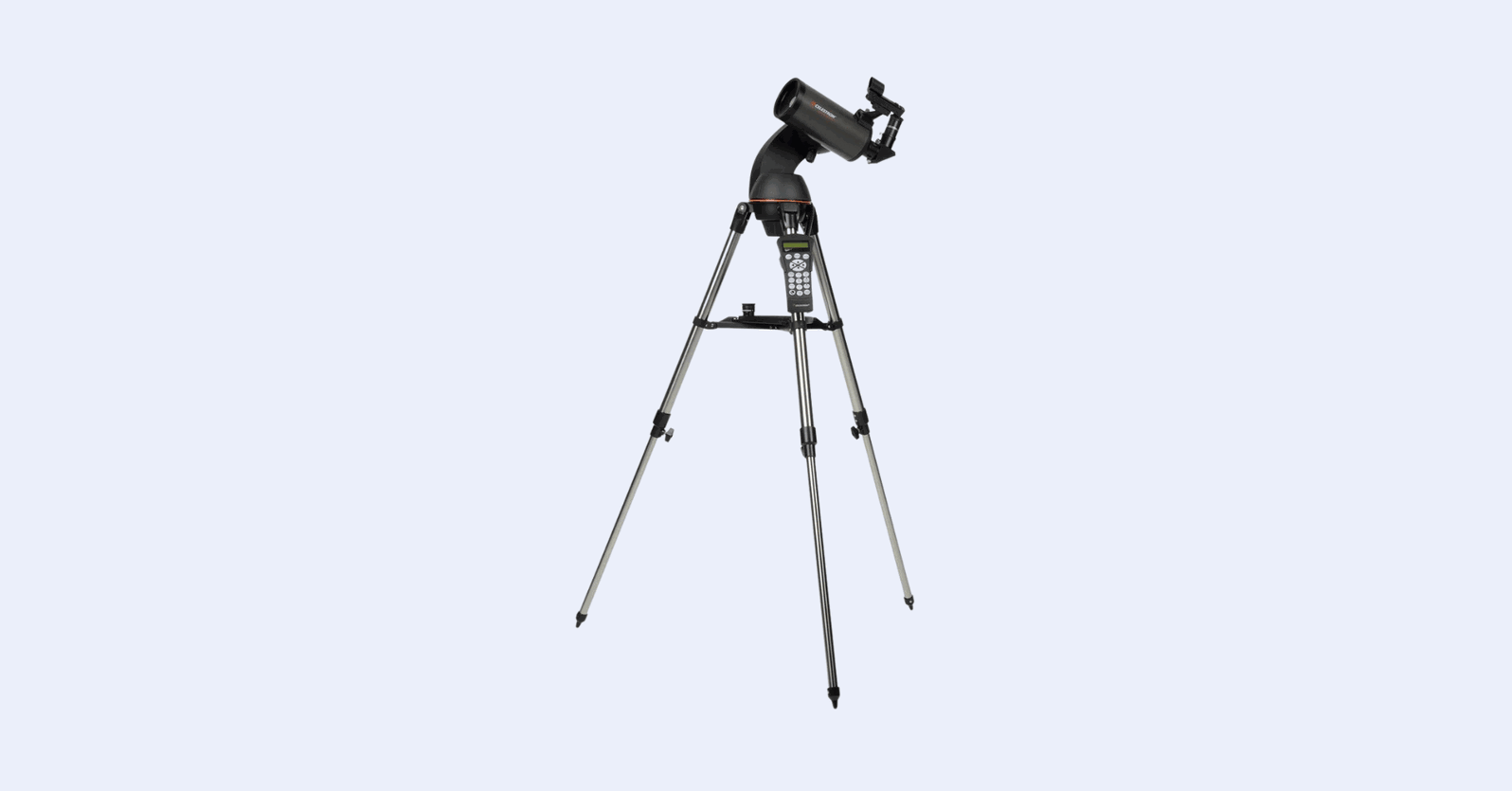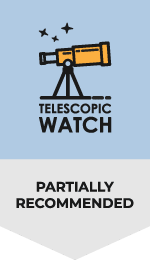The Optical Tube’s Performance and Usage

The NexStar 90SLT is a 90mm Maksutov-Cassegrain with a focal length of 1250mm and a focal ratio of f/13.3. I’ve seen a variety of other telescopes use the exact same optics as the 90SLT with no appreciable differences.
The optics in the 90SLT are superb in quality, but I’m severely limited in light-gathering power and resolution due to the telescope’s small 90mm aperture.
Being a Maksutov, there’s little to no need to collimate the telescope, and the mechanisms to do so are not really provided in any case.
Focusing the 90SLT is accomplished by turning a knob at the back of the scope, which moves the primary mirror back and forth on a rod inside the tube. Thanks to the mirror’s minuscule size and weight, the image does not “shift” during focusing as it can with some catadioptric instruments.
The scope uses a proprietary threaded adapter as a 1.25” visual back to hold the diagonal. I’d warn you to not lose this adapter and not to unscrew it, as replacing it is difficult. I couldn’t use a 2” diagonal or focal reducer on the 90SLT due to severe vignetting.
The 90SLT attaches to its mount with a short Vixen-style dovetail rail, making it compatible with a variety of other mounts and tripods. It can also be attached to most heavy-duty photo tripods with the threaded ¼ 20 holes in the dovetail bar.
The Low-Quality, But Adequate Kellner Eyepieces
The NexStar 90SLT Mak comes with two 1.25” barrel eyepieces: a 25mm Kellner unit providing 50x for “low” magnification and a 10mm Kellner ocular providing 125x for higher power.
Both the eyepieces are all-metal in construction and fairly good quality when I tried them out. Both have apparent fields of view of 50 degrees, which provides about 1 degree of a true field (2 full moons) with the 25mm and about 0.4 degrees (a bit smaller than the Moon) with the 10mm.
Normally I’d say that a pair of two Kellner eyepieces is inadequate for a telescope, but in the case of the 90SLT, there really isn’t much of a purpose in buying anything else. A lower-power eyepiece than the 25mm would actually vignette somewhat due to the 90SLT’s small baffle tube, and I can’t really push the scope past 150x magnification, which isn’t appreciably different from 125x the 10mm provides.
The High-Quality Diagonal and Adequate Red Dot Finder
The 90SLT also comes with a 1.25” prism star diagonal, which I basically need to use the telescope. It’s quite high quality and works well.
For a finder, Celestron’s standard “StarPointer” red dot is included. A red dot finder is more than adequate for such a small aperture instrument. Additionally, we are really only supposed to use it to align the GoTo mount anyway, after which the 90SLT’s electronics take over the task of aiming the telescope at targets.
My Take On The NexStar SLT Mount
The NexStar SLT mount is essentially just an updated NexStar GT mount, which has been around since the early 2000s. The same mount and tripod hardware are also used in the SkyProdigy and Astro-Fi mounts.
One of the complaints I often hear about the SLT mount is its lack of stability. This is a problem I’ve experienced with pretty much all of the larger telescopes in the SLT line, but the 90SLT optical tube is short and weighs next to nothing. The SLT mount supports the 90SLT optical tube with ease, despite the mount’s mechanical shortcomings.
The mount is a GoTo design, and unlike many newly introduced GoTo telescopes, I cannot move it manually at all. I have to power it up in order to use it. This means that even though it’s quite easy to carry the entire telescope in one hand, setting it up by leveling the tripod, turning the mount on, and aligning the GoTo system with a few bright stars takes a minimum of five to ten minutes of my effort. As such, the convenience factor that exists in a small, low-maintenance, and compact instrument is greatly diminished.
The mount doesn’t even have an internal clock, so I have to set the date and time every time I turn it on as well.
The database on the NexStar SLT mount’s hand controller contains about 4,000 objects. I can’t see many of these with the 90SLT due to its small aperture, especially under suboptimal conditions. I’m limited to the brightest galaxies, star clusters, nebulae, and, of course, the Moon and planets.
The main utility of the SLT mount with this scope is arguably the motorized tracking, which is pretty accurate, if a bit jerky at times and quite loud.
For those who do not enjoy the hand controller, Celestron sells a Wi-Fi adapter for the SLT mount that you can use to run it off your phone. But you could also just buy the Astro-Fi 102 model Celestron sells, which has more aperture, largely the same features, and runs off a phone or tablet by default.
For power, the NexStar SLT mount requires 8 AA batteries, which lasted a few hours at most on my field observations. This was inconvenient and could’ve become expensive rapidly. As such, I use a portable DC power supply instead. But I always leave the batteries in, just in case a loose connection turns the mount off and requires restarting and re-aligning, which gets infuriating.
Should I buy a Used NexStar 90SLT?
A used 90SLT is still a 90SLT, and its usefulness is limited. But at the right price and assuming the telescope has been reasonably well taken care of, there’s not too much to worry about if the mount powers on and the optics of the telescope are in good shape.
Alternative Recommendations
The NexStar 90SLT is one of the least cost-effective telescopes in its price range. While my recommendation would probably be to steer you towards choosing a manual Dobsonian telescope, there are also a variety of superior computerized instruments and numerous other options offering greater portability and/or performance.
Under $400
- Manual Scope (Best): The Sky-Watcher Heritage 150P offers nearly triple the light-gathering ability and double the resolving power of the NexStar 90SLT, with a compact and easy-to-use tabletop Dobsonian design and collapsible tube for portability. Its short 750mm focal length also provides a wider field of view than the 90 SLT.
$400-$600
- Manual Scope (Best): The Apertura AD6 Classic offers similar performance to the Sky-Watcher 150P models but doesn’t require a table thanks to its full-sized base, and at f/8 it’s easier to collimate. The scope also features a high-quality 2” Crayford focuser for holding heavy oculars.
- Computerized Scope (Best): The Sky-Watcher Virtuoso GTi 150P Dobsonian GoTo offers full motorized tracking and GoTo capabilities like the 90SLT but uses the Heritage 150P’s simple manual Dobsonian mount as a base, and its FreedomFind encoders allow manual aiming while the GoTo is controlled with your smartphone/tablet. The 150mm of aperture, of course, easily bests the NexStar 90SLT too.
- Computerized Scope (Best with Tripod): The Celestron Astro Fi 130 GoTo uses a modernized NexStar SLT mount controlled via your smartphone/tablet and with beefed-up tripod legs, while the 130mm f/5 optics offer similar views to the Sky-Watcher 130P scopes with the addition of a 2” focuser, easily besting the NexStar 90SLT in resolving power, achievable field of view, and light-gathering ability.
- Computerized Scope: The Celestron Astro Fi 102 GoTo is a little larger in aperture than the 90SLT while sharing its sleek Maksutov-Cassegrain optical configuration and riding the easy-to-use and rock-steady AstroFi mount/tripod, which is similar to the NexStar SLT mount. However, it is still lacking in aperture, and the ultra-long focal length combined with 1.25”-only eyepiece capability constrains its field of view and thus limits deep-sky views even further, as with the NexStar 90SLT.
$600-$800
- Manual Scope (Best): The Apertura AD8 blows away smaller scopes like the 90SLT with its huge 8” aperture, rock-solid Dobsonian base, high-quality accessory set, and features like a dual-speed 2” Crayford focuser. It’s one of our top picks for a beginner scope for good reason. The larger AD10 is also an excellent pick.
- Partially Computerized Scope: The Celestron StarSense Explorer 8” Dobsonian offers computerized pointing assistance via its StarSense Explorer technology coupled to your smartphone, as well as a lighter and more easily transported base compared to the AD8. However, few accessories are included, and collimation of the 8” model is annoying. The 10” StarSense Explorer is an even better choice thanks to its similar form factor, easy collimation, and equally great design in all other aspects, though it’s of course quite expensive.
Aftermarket Accessories Recommendations
The only accessories that are really necessary for the NexStar 90SLT are a dew shield and some type of rechargeable power supply.
A dew shield for the 90SLT can be homemade, or you can buy one like the AstroZap hard plastic dew shield. In addition to keeping moisture off the scope’s front corrector plate, a dew shield helps reduce glare and reflections inside the telescope, which can be a nuisance when viewing.
A power supply doesn’t have to be big or expensive to run the SLT mount and push around such a lightweight instrument. A small Talentcell unit taped or tied to the tripod is more than sufficient.
Additional eyepieces could provide slightly more flexibility with the 90SLT but are largely redundant and unnecessary for this instrument.
Observing Targets That I’d Try If I Were You
A 90mm Maksutov is widely regarded as primarily a quick-look or “grab n’ go” instrument, capable of giving sharp views of solar system objects but not much else.
- Mercury’s small angular size and proximity to the Sun mean it’s downright impossible to see any detail on it with any telescope, and its lack of visibility also makes it difficult to locate. The 90SLT’s GoTo mount somewhat helps in this regard, though getting it ready before Mercury sinks below the horizon is difficult. The 90SLT is able to show me its phase.
- Venus is much easier to see and much bigger, but its surface is completely obscured by dazzlingly reflective cloud cover.
- The Moon looks fantastic in the 90SLT’s eyepiece, with craters, ridges, and mountains only a few miles wide easily visible. The views are best around the first quarter, when the Moon is high in the sky but not blindingly bright or lacking in shadows.
- Mars similarly requires good timing; the planet is only close enough to Earth to show detail for a few months out of every 2-year period. When Mars is close to opposition, I could see a few dark markings on its surface and an ice cap with the NexStar 90SLT, albeit not much else.
- Jupiter looks fantastic with the NexStar 90SLT; its four largest moons are easily visible moving around the planet, and Jupiter itself shows a number of colorful cloud bands. The Great Red Spot is difficult to perceive at times, however, and the 90SLT lacks the resolving power to clearly and consistently show the moons as actual disks or their shadows when they transit across Jupiter itself.
- Saturn’s rings and the Cassini Division within them are easily spotted with the NexStar 90SLT, and its cloud bands can also be faintly seen. Titan is fairly obvious, but the fainter moons are harder to spot on account of their low brightness.
- Uranus and Neptune appear as merely bluish dim, star-like points, as seen in the NexStar 90SLT, with the telescope’s small aperture insufficient to clearly resolve the disk of either planet nor grasp the dim glow of their moons. Identifying Neptune in particular as being distinct from nearby stars may even present a challenge.
The NexStar 90SLT will have a hard time showing anything at all of the deep-sky objects from a light-polluted location. Its narrow field of view does not help.
- Open star clusters barely fit in the field of view in some cases.
- Similarly, the 90SLT is too “zoomed in” to take in bright and eye-popping views of emission nebulae like Orion or the Lagoon.
- Globular clusters reveal a few of their outer members under perfect viewing conditions, but by and large they remain to appear as simply unresolved fuzzy blobs.
- Planetary nebulae like the Ring and Dumbbell can be seen, but they are dim and lack detail.
- Galaxies are perhaps the most disappointing thing of all; even under dark skies, the 90SLT shows me only the brightest galaxies with little to no detail, and under light-polluted conditions, anything beyond Andromeda and M82 is invisible.
- The 90SLT’s biggest strength on objects outside the Solar System is arguably double stars. I’m able to resolve many of them into perfect, colorful, tiny disks just barely touching each other at high magnification under steady skies. The scope’s plentiful database can also easily find many of them, and of course, even under light-polluted skies, I have no trouble splitting doubles.
Astrophotography Capabilities
The NexStar 90SLT is completely incapable of deep-sky astrophotography on account of its super-long focal ratio and completely insufficient mount. However, it can be used for some lunar and planetary astrophotography with a high-speed astronomical video camera and a Barlow lens. You simply take a short video, stack it in a program like RegiStax or AutoStakkert, and conduct final processing.



